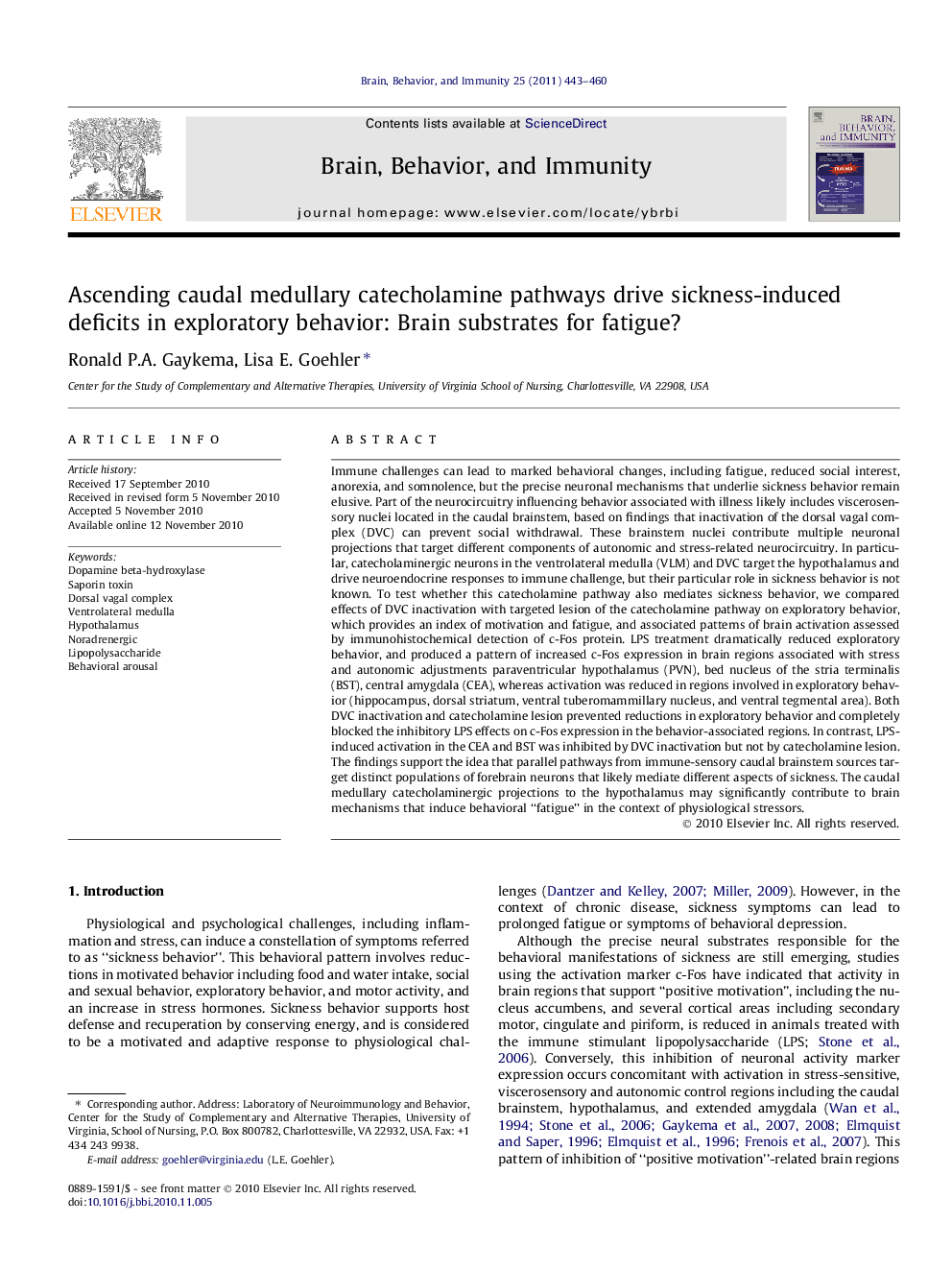| کد مقاله | کد نشریه | سال انتشار | مقاله انگلیسی | نسخه تمام متن |
|---|---|---|---|---|
| 10454874 | 921038 | 2011 | 18 صفحه PDF | دانلود رایگان |
عنوان انگلیسی مقاله ISI
Ascending caudal medullary catecholamine pathways drive sickness-induced deficits in exploratory behavior: Brain substrates for fatigue?
دانلود مقاله + سفارش ترجمه
دانلود مقاله ISI انگلیسی
رایگان برای ایرانیان
کلمات کلیدی
موضوعات مرتبط
علوم زیستی و بیوفناوری
ایمنی شناسی و میکروب شناسی
ایمونولوژی
پیش نمایش صفحه اول مقاله

چکیده انگلیسی
Immune challenges can lead to marked behavioral changes, including fatigue, reduced social interest, anorexia, and somnolence, but the precise neuronal mechanisms that underlie sickness behavior remain elusive. Part of the neurocircuitry influencing behavior associated with illness likely includes viscerosensory nuclei located in the caudal brainstem, based on findings that inactivation of the dorsal vagal complex (DVC) can prevent social withdrawal. These brainstem nuclei contribute multiple neuronal projections that target different components of autonomic and stress-related neurocircuitry. In particular, catecholaminergic neurons in the ventrolateral medulla (VLM) and DVC target the hypothalamus and drive neuroendocrine responses to immune challenge, but their particular role in sickness behavior is not known. To test whether this catecholamine pathway also mediates sickness behavior, we compared effects of DVC inactivation with targeted lesion of the catecholamine pathway on exploratory behavior, which provides an index of motivation and fatigue, and associated patterns of brain activation assessed by immunohistochemical detection of c-Fos protein. LPS treatment dramatically reduced exploratory behavior, and produced a pattern of increased c-Fos expression in brain regions associated with stress and autonomic adjustments paraventricular hypothalamus (PVN), bed nucleus of the stria terminalis (BST), central amygdala (CEA), whereas activation was reduced in regions involved in exploratory behavior (hippocampus, dorsal striatum, ventral tuberomammillary nucleus, and ventral tegmental area). Both DVC inactivation and catecholamine lesion prevented reductions in exploratory behavior and completely blocked the inhibitory LPS effects on c-Fos expression in the behavior-associated regions. In contrast, LPS-induced activation in the CEA and BST was inhibited by DVC inactivation but not by catecholamine lesion. The findings support the idea that parallel pathways from immune-sensory caudal brainstem sources target distinct populations of forebrain neurons that likely mediate different aspects of sickness. The caudal medullary catecholaminergic projections to the hypothalamus may significantly contribute to brain mechanisms that induce behavioral “fatigue” in the context of physiological stressors.
ناشر
Database: Elsevier - ScienceDirect (ساینس دایرکت)
Journal: Brain, Behavior, and Immunity - Volume 25, Issue 3, March 2011, Pages 443-460
Journal: Brain, Behavior, and Immunity - Volume 25, Issue 3, March 2011, Pages 443-460
نویسندگان
Ronald P.A. Gaykema, Lisa E. Goehler,